ASUS PQ321Q UltraHD Monitor Review: Living with a 31.5-inch 4K Desktop Display
by Chris Heinonen on July 23, 2013 9:01 AM ESTUniformity is tested by using 25 locations across the screen and measuring the color checker chart at each of them. From there we can pull out contrast, black and white uniformity, and color uniformity. This review is the first to utilize the newest measurement available in CalMAN 5.1.2: dE From Center. Now instead of measuring the dE2000 at every location, we measure it relative to the center measurement.
This gives us a true uniformity measure. I could measure the left side and the right side of the monitor and get a dE2000 of 2.0 for each side. What that doesn’t tell me is that the left side might be red tinted, and the right side blue tinted, while the center might be green tinted. In this case they could all measure the same dE2000, but look totally different. By comparing the measured values to the center, we get an actual measurement of if one area of the screen will look the same as another area. Since we always use the center of the screen as our calibration target, which is why everything is measured relative to that.
Starting out with White Uniformity, we see decent but not amazing results. The panel stays within +/- 10% for the center, but falls down to a 17% variation at the edges. The light fall-off is relatively high, and makes me wonder if the look of the panel, and its thin design, might place a bit of emphasis on style over substance.
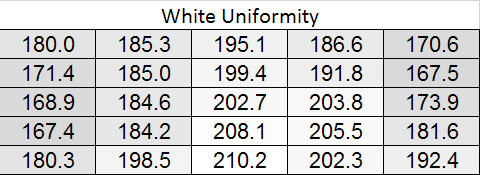

With the black level charts we see similar results. The middle of the panel is +/- 10% again, but the edges fall off to a nearly 20% difference. There is a curious rise in black level in one measure where there was a fall-off in white level, but otherwise the results between the two measurements are similar.
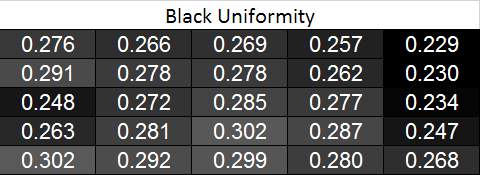
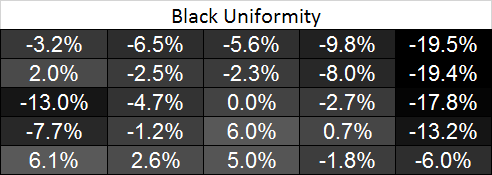
Looking at the resulting contrast, the numbers here are much closer to 100%, which we expect to see. Areas with light fall-off affect the white and black levels almost equally, so the contrast ratios are very similar all across the screen. That gives us a 700:1 expected contrast ratio for the screen as a whole.
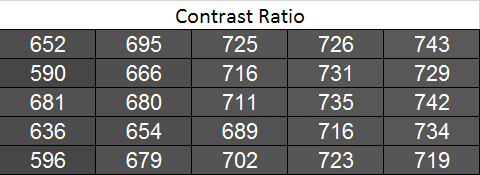
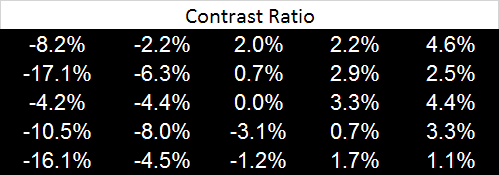
Now we can see the new dE2000 From Center data. The issues here crop up at the outsides of the screen, where we see the backlighting issues earlier. Uneven lighting is the issue most likely to cause color issues on the screen, and that is certainly backed up here. In the center of the screen, you are going to not see a difference in colors when you look directly at the screen. With a light loss of less than 10%, and a color dE2000 of <2 for most of the center screen, everything will look identical. As you get to the extreme edges you will run into more issues. I will need more monitors to be tested with this new method, but I think this is going to wind up as a good result in the end.

Going with an LED lighting system, and not a backlit array one, is always a bit of a concern for me. Overall the PQ321Q does well for uniformity for using one, and it avoids some of the massive issues we have seen with some LED systems before. But we are looking for near-perfection from the ASUS and it can’t quite do that. The center 60% of the screen is excellent overall, and for most people that will mean you may not notice these issues at all, but they are there.










166 Comments
View All Comments
peterfares - Wednesday, July 24, 2013 - link
It's pretty easy to tell why they're getting 3200x1800 monitors. The super high DPI at that size and distance is unnecessary, but it has one HUGE advantage: You can use 200% scaling. That means things that aren't DPI-aware can run at standard DPI and then be doubled in width and height. This avoids the fuzzy effect like this article was complaining about when you use 150% on unsupported programs. With 200% scaling they'll look just like they do on a standard DPI display, not worse which is when happens when you use a decimal scaling factor.APassingMe - Tuesday, July 23, 2013 - link
I'm concerned since you mention the "low" contrast numbers. The last time I checked, any number over 100:1 was due to software enhancements and was equivalent to a higher quality contrast that racked lower due to not having much or any software enhancement meaning that the current contrast numbers thrown around are just a bunch of marketing jumble.So wouldn't it be better to just measure the contrast with a 3rd party tool? As the numbers provided from the manufacture are pretty much a product of fiction + the marketing team, just my two cents
APassingMe - Tuesday, July 23, 2013 - link
my bad, that's ranked* not rackedcheinonen - Tuesday, July 23, 2013 - link
The number on the specs page is the one that the manufacturer quotes. In the test results you can see what we actually found. Desktop LCD numbers far fall behind what is possible with plasma TVs and the best LCOS projectors, or ever rear array LCD TVs. 100:1 would be insanely low and a poor design. Desktop LCDs are capable of 1000:1, without any sort of trick.APassingMe - Tuesday, July 23, 2013 - link
I see, I could of been confusing the data with that from projectors; regardless I'm glad the test results are posted regardless as the definition of "contrast" can be a varying thing. Thanks for the swift responsefreedom4556 - Tuesday, July 23, 2013 - link
Yeah, you were definitely thinking of those "dynamic" contrast ratios that are complete BS. They are usually more in the 100,000:1 or 1,000,000: range, though. Completely unreasonable.sheh - Tuesday, July 23, 2013 - link
The official specs table lists the contrast as "800:01:00".cheinonen - Tuesday, July 23, 2013 - link
Great, I'll fix that since apparently Excel decided to change that to a time or something else. But it's fixed now.Streetwind - Tuesday, July 23, 2013 - link
31.5 inch is still too big for me. I'm not puttin anything over 24" on my desk. I've tried it, and I just can't like it.Unfortunately it seems that vendors are producing either tiny portable screens or gigantic TVs, and no real midsize desk monitors anymore. At least not outside the same old 1080p that we've been getting for the past 4 years.
cheinonen - Tuesday, July 23, 2013 - link
Well rumors are that Dell might be coming out with a 24" UHD display using a panel from LG. If that happens then I'll be happy to review that as well.